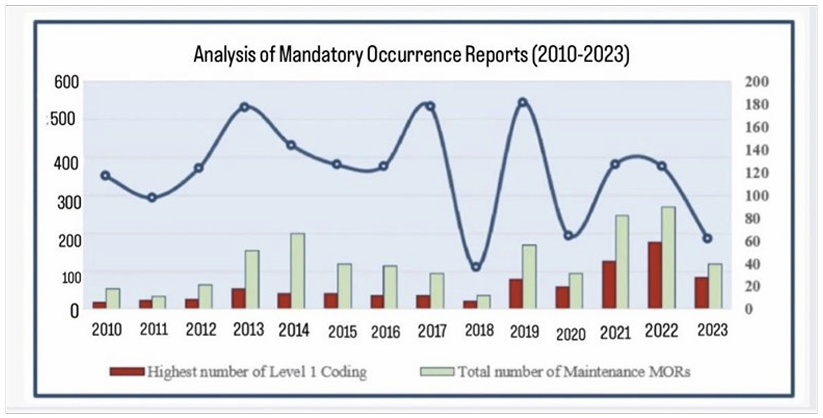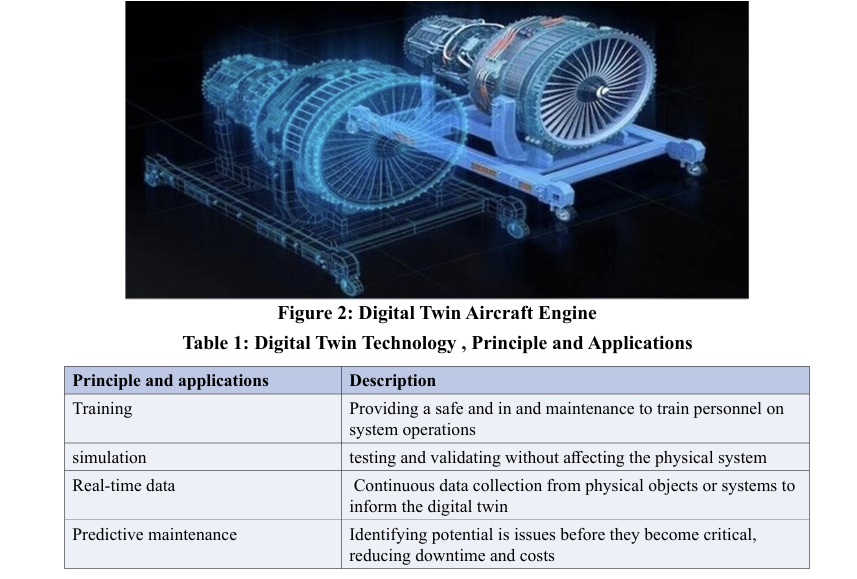Research Article - (2024) Volume 1, Issue 1
Aircraft Engine Maintenance and Digital Twin Technology in Aircraft Engines
Received Date: May 15, 2024 / Accepted Date: Jun 04, 2024 / Published Date: Jun 21, 2024
Copyright: ©2024 Anahita Moghtadaei. This is an open-access article distributed under the terms of the Creative Commons Attribution License, which permits unrestricted use, distribution, and reproduction in any medium, provided the original author and source are credited.
Citation: Moghtadaei, A. (2024). Aircraft Engine Maintenance and Digital Twin Technology in Aircraft Engines. J Data Analytic Eng Decision Making, 1(1), 01-05.
Abstract
Aircraft engine maintenance stands as a critical aspect of aviation safety and operational efficiency. Traditional methods often rely on periodic inspections and scheduled maintenance routines, which may not fully capture the dynamic conditions and po- tential anomalies within the engine. This article explores the integration of digital twin technology into aircraft engine mainte- nance processes, offering real-time monitoring, predictive analytics, and explanations of the role of human factors in aircraft engine maintenance are given and explain simulation capabilities to optimize maintenance strategies and enhance overall reli- ability. Through a comprehensive review of current practices and emerging trends, this article highlights the potential benefits and challenges of adopting digital twin technology in the aviation industry.
Introduction
Aircraft engines are the heart of any aircraft, providing the necessary power for take-off, flight, and landing. They are complex machines that consist of various components, such as compressors, turbines, and combustion chambers, which must work together seamlessly to ensure the safe and efficient operation of the aircraft. Any failure in the engine can have catastrophic consequences, including loss of aircraft control, engine failure, or even a crash. Regular engine maintenance is critical in ensuring the reliability and safety of aircraft engines. Preventive maintenance, in particular, plays a vital role in detecting issues before they escalate, thereby preventing engine failures and ensuring safe flights. Preventive maintenance includes regular inspections, repairs, and overhauls, which help identify and address potential problems before they become critical. By investing in preventive maintenance, airlines can save significant costs associated with engine repairs and replacements, as well as prevent catastrophic accidents. Technology plays a crucial role in modern engine maintenance, with predictive maintenance systems and digital twin technology being at the forefront. Predictive maintenance systems use data analytics and machine learning algorithms to predict potential engine failures before they occur, allowing maintenance personnel to take proactive measures to prevent them. Digital twin technology, on the other hand, creates a virtual replica of the engine, enabling maintenance personnel to simulate different scenarios and identify potential issues before they become critical. By leveraging these technologies, airlines can improve engine reliability, reduce maintenance costs, and enhance safety. Digital Twin Technology is a revolutionary concept that leverages advanced data analytics, machine learning, and artificial intelligence to create a virtual replica of a physical object or system. In the aviation industry, this technology is being increasingly adopted for aircraft engines, allowing for real time monitoring, predictive maintenance, and improved efficiency. This article will explore the potential of Digital Twin Technology in aircraft engines, its benefits, and applications.
Impact Human Factor in Engine Maintenance
Knowledge of human factors can play an important role in preventing disputes arising from aircraft maintenance. By understanding the situational characteristics and general human error tendencies that contribute to maintenance error, actions can be taken that reduce the likelihood of such errors occurring. Methods and tools for identifying, reporting and managing human error in aviation maintenance and inspection include training. Schedules, checklists and data analysis. Communication with industry professionals and organizations is high, as these methods can significantly improve overall system reliability and safety. Aircraft engine maintenance programs, procedures, and outcomes vary by engine and aircraft type. Comparing and contrasting these factors can provide valuable insights into best practices and areas for improvement in engine maintenance. Outsourcing, transportation, maintenance planning, inventory management, organizational culture, and human factors are all issues that can affect the effectiveness of aircraft engine MRO. By addressing these issues and implementing best practices, system reliability and safety can be significantly improved. Maintenance technicians play a critical role in ensuring the reliability and airworthiness of aircraft engines. Human factors considerations influence maintenance procedures, tool design, training programs, and work environment ergonomics to minimize error, fatigue, and injury risks. Clear labelling, standardized procedures, and intuitive tool design help streamline maintenance tasks and reduce the likelihood of human error.

Figure 1: Analysis of Mandatory Reports
Provided chart examines the Mandatory Occurrence Reports (MORs) spanning from 2010to 2023. It focuses on two key aspects: the highest count of Level 1 Coding incidents and the overall number of Maintenance MORs. The total number of MORs experiences fluctuations throughout the years, with the lowest count observed in 2018.In recent years, there has been a noticeable increase in maintenance-related MORs, which now constitute over 40% of the total count. The highest number of Level 1 Coding incidents varies annually, with notable peaks occurring in 2013, 18 (incidents) and 2020 , (26 incidents).
Digital Twin Technology
Digital twin technology in aircraft engines involves creating a virtual replica or "twin" of an aircraft engine in the digital realm. This virtual model is a detailed representation of the physical engine including its structure, components and operational behavior. The digital twin is connected to the physical engine via sensors that continuously collect data on various parameters such as temperature, pressure, vibration, fuel consumption and operational performance. This real-time data is then transmitted to the digital twin for analysis. Using advanced analytics and machine learning algorithms, the digital twin processes data to monitor engine health, detect potential problems and predict future performance. It can identify unusual patterns or deviations from normal operating conditions, allowing maintenance crews to take preventative action before problems escalate. In addition, digital twins enable the simulation of various scenarios and "what if" analyses. Engineers can virtually test maintenance strategies, simulate different operating conditions, and evaluate the impact of possible engine modifications or upgrades. Digital twin technology is a combination of data-driven models, simulations and real-time data analysis. In the field of aircraft engines, digital twins are created by integrating data from various sources such as sensors, flight data recorders and maintenance logs. This data is then used to create a comprehensive virtual copy of the engine that can be used for a variety of purposes including real time monitoring, performance optimization and predictive maintenance. Software plays an important role in digital twin technology, as it enables the creation, management and analysis of the vast amount of data required to maintain an accurate and up-to date digital twin. The implementation of Digital Twin Technology in aircraft engines offers numerous benefits, including improved maintenance efficiency, reduced downtime and costs, enhanced safety, and increased performance. By providing real-time insights into the condition and performance of aircraft engines, Digital Twins enable maintenance teams to identify and address potential issues before they become critical, thereby reducing the need for unscheduled maintenance and minimizing downtime. Additionally, Digital Twins can help optimize engine performance, leading to improved fuel efficiency and reduced emissions. Several airlines and aircraft manufacturers have already successfully implemented Digital Twin Technology in their aircraft engines. For example, Rolls-Royce has been using Digital Twins to monitor and maintain their Trent XWB engines, which power the Airbus A350 XWB. By leveraging Digital Twin Technology, Rolls Royce has been able to reduce engine downtime, improve maintenance efficiency, and enhance overall engine performance. However, implementing Digital Twin Technology in aircraft engines is not without its challenges, such as data privacy, security, and the need for standardized data formats.

Case of Study on Aviation Engine Maintenance and Safety
Proper engine maintenance has had a significant impact on flight safety. For example, in 2010, a Qantas Airways A380 experienced an uncontained engine failure shortly after take-off, causing debris to damage the wing and fuel tanks. However, the crew was able to safely land the aircraft due to the engine's redundancy and the crew's training. The incident highlighted the importance of regular engine maintenance and the need for airlines to invest in predictive maintenance systems to prevent similar incidents in the future. In another case, Southwest Airlines experienced an engine failure in 2018, resulting in the death of a passenger. The incident was attributed to metal fatigue in the engine fan blade, which could have been detected through regular inspections and maintenance.

Digital Twin Technology in Aircraft Maintenance, Repair, and Overhaul
Digital twin technology has significant applications in the maintenance, repair, and overhaul (MRO) of aircraft. It can be used for health status evaluation, future health status prediction, and maintenance activity management. By using digital twin technology, maintenance technicians can monitor the health status of aircraft engines in real-time, predict future failures, and plan maintenance activities accordingly, leading to increased efficiency, cost savings, and improved safety. Overall, digital twin technology enhances the efficiency, cost-effectiveness, and safety of aircraft maintenance operations by enabling real-time monitoring, predictive analytics, and proactive maintenance planning. By leveraging digital twins, maintenance technicians can ensure that aircraft engines remain in optimal condition, ultimately leading to increased reliability, reduced costs, and improved safety in aviation operations.

Conclusion
Engine maintenance is a critical component of aviation safety, ensuring the reliability and safety of aircraft engines. Regular inspections, repairs, and overhauls, as well as preventive maintenance, play a vital role in detecting issues before they escalate and preventing engine failures. Technology, including predictive maintenance systems and digital twin technology, can help improve engine reliability, reduce maintenance costs, and enhance safety. By investing in engine maintenance and adhering to best practices, airlines can ensure safe and efficient flights, protecting both passengers and crew. Digital twin technology has the potential to revolutionize aircraft engine maintenance, providing real-time monitoring, predictive maintenance, and optimization capabilities. While there are challenges to its implementation, ongoing research and development efforts are expected to lead to more sophisticated and widely adopted digital twin technology in the aerospace industry. The future vision for aircraft engine maintenance with digital twin technology is one of increased efficiency, cost savings, and safety [1-12].
References
1. Liu, X. (2023). A New Perspective on Digital Twin-Based Mechanical Design in Industrial Engineering. Innovations in Applied Engineering and Technology.
2. Li, L., Aslam, S., Wileman, A., & Perinpanayagam, S. (2021). Digital twin in aerospace industry: A gentle introduction. IEEE Access, 10, 9543-9562.
3. Ma, N. N. (2013). Statistical analysis of the failure modes and causes of the failure blades of the aviation engine. Applied Mechanics and Materials, 268, 2097-2100.
4. Shahriari, M., & Aydin, M. E. (2018). Aviation Accident Analysis: A Case Study. In Advances in Safety Management and Human Factors: Proceedings of the AHFE 2017 International Conference on Safety Management and Human Factors, July 17–21, 2017, The Westin Bonaventure Hotel, Los Angeles, California, USA 8 (pp. 77-85). Springer International Publishing.
5. Daily, J., & Peterson, J. (2017). Predictive maintenance: How big data analysis can improve maintenance. Supply chain integration challenges in commercial aerospace: a comprehensive perspective on the aviation value chain, 267 278.
6. Moenck, K. H., Laukotka, F. N., Deneke, C., Schüppstuhl, T., Krause, D., & Nagel, T. J. (2022). Towards an intelligent digital cabin twin to support an aircraft's retrofit and base maintenance (sae paper 2022-01-0046) (No. 2022-01-0046). SAE Technical Paper.
7. Xiong, M., & Wang, H. (2022). Digital twin applications in aviation industry: A review. The International Journal of Advanced Manufacturing Technology, 121(9), 5677-5692.
8. Singh, M., Srivastava, R., Fuenmayor, E., Kuts, V., Qiao, Y., Murray, N., & Devine, D. (2022). Applications of digital twin across industries: A review. Applied Sciences, 12(11), 5727.
9. Meyer, H., Zimdahl, J., Kamtsiuris, A., Meissner, R., Raddatz, F., Haufe, S., & Bäßler, M. (2020). Development of a digital twin for aviation research.
10. Moenck, K., Rath, J. E., Koch, J., Wendt, A., Kalscheuer, J Data Analytic Eng Decision Making 2024 F., Schüppstuhl, T., & Schoepflin, D. (2024). Digital twins in aircraft production and MRO: challenges and opportunities. CEAS Aeronautical Journal, 1-17.
11. Afshari, S. S., Jonnadula, B., Xu, X., Liang, X., & Yang, Z. (2022). Jet engine optimal preventive maintenance scheduling using golden section search and genetic algorithm. Journal of Prognostics and Health Management, 2(1), 45-71.
12. Airbus A380-842, Federal Aviation Administration



